Content
- 1 Eustoma - what is it?
- 2 Description
- 3 Varieties and hybrids
- 4 Features of eustoma
- 5 Reproduction methods
- 6 The soil
- 7 Pollination
- 8 Sowing
- 9 Picking
- 10 We plant seedlings in the garden
- 11 Different approaches to growing eustoma
- 12 Growing eustoma in the garden and greenhouses
- 13 Growing eustoma as a house or garden pot plant
- 14 Varieties and their features
Land improvement is a top priority for many gardeners. Harvesting is, of course, good, but beauty should please the eye. There are many ornamental plants that will decorate your garden. These include eustoma, or lisianthus. The description of this flower contains the best epithets. The adorable plant can be grown both in pots and outdoors.
Eustoma - what is it?
Eustoma is a perennial ornamental plant. Central America is considered his homeland. Eustoma belongs to the gentian family. Today this plant has many varieties and hybrids. Lisianthus flowers (second name) have a wide variety of colors. They are large and resemble a rose inflorescence. Due to its external data, eustoma, planting, reproduction and care of which require certain skills, has become the most popular decorative flower among gardeners and florists.
Description
A perennial plant, which can be annual in cold climates, has large flowers of various shades - from white to multi-colored. They resemble a half-open rosebud, but the stems of the eustoma do not have thorns. They reach a height of no more than 50 centimeters. However, due to heavy branching, one branch can look like a bouquet. Lisianthus leaves are matte with a bluish tint and waxy texture. For planting in pots and growing in a room, dwarf varieties are used, which have a height of no more than 30 centimeters. One bush of a plant can have up to 35 buds.
Varieties and hybrids
Perennial eustoma, planting by the root of which is considered ineffective in most cases, has a sufficient number of varieties and hybrids. It is a moody plant that prefers warmth and moisture. However, thanks to breeders, varieties and hybrids were bred that are more adapted to modern weather conditions. Today, the seeds and seedlings of this plant are available not only to professional florists, but also to ordinary amateur gardeners.
A large number of varieties and colors have made eustoma very popular. For example, the terry series "Kyoto" and "Echo", as well as non-double types "Twinkie" and "Mermaid" found a good response from florists.
Features of eustoma
Eustoma blooms, the care of which has its own characteristics, from early July to October. One plant can produce flower stalks throughout this period if not cut. After cutting the bush at the root, new shoots appear, but they bloom again only in warm areas. Low-growing varieties are more suitable for balconies and window sills. Tall types of eustoma are used to decorate personal plots and for cutting. Florists love this flower for its portability. Even after being cut, it stays beautiful and fresh for a long time.
Reproduction methods
Perennial eustoma, planting by the root of which is possible only from seedlings grown from seeds, has its own characteristics of reproduction.The vegetative way of breeding eustoma is not considered correct. This plant has a very delicate root system. Therefore, careless actions when dividing a bush can lead to its death.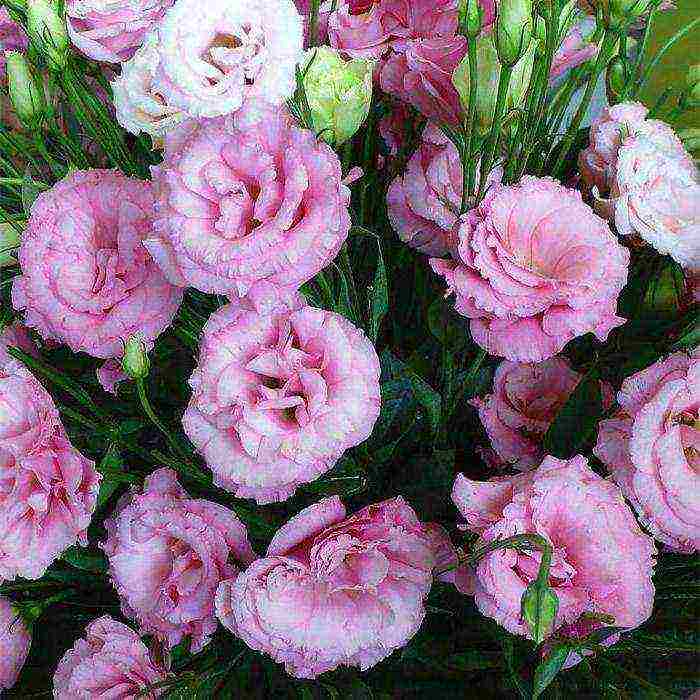
The effectiveness of such operations is very low. Plant cuttings do not take root well, so this method is also not suitable. The best option is seed material or ready-made seedlings. They can be purchased at specialized stores. This method is more troublesome, but also effective. Planting and caring for an eustoma flower will pay off when it pleases with its magnificent view.
The soil
To grow a beautiful, healthy plant, it is necessary to observe everything that requires planting an eustoma (soil, sowing time). You can simplify the process and buy ready-made potting mix at the store. It should be identical to the one for violets or saintpaulias. For greater efficiency, you can add sand to it. The soil for eustoma should be light with good air access and neutrality. The second option is to prepare the soil yourself. To do this, you need to take two parts of good garden soil, one part of sand, four parts of peat and 1-2 tablespoons of ash for each liter of mixture.
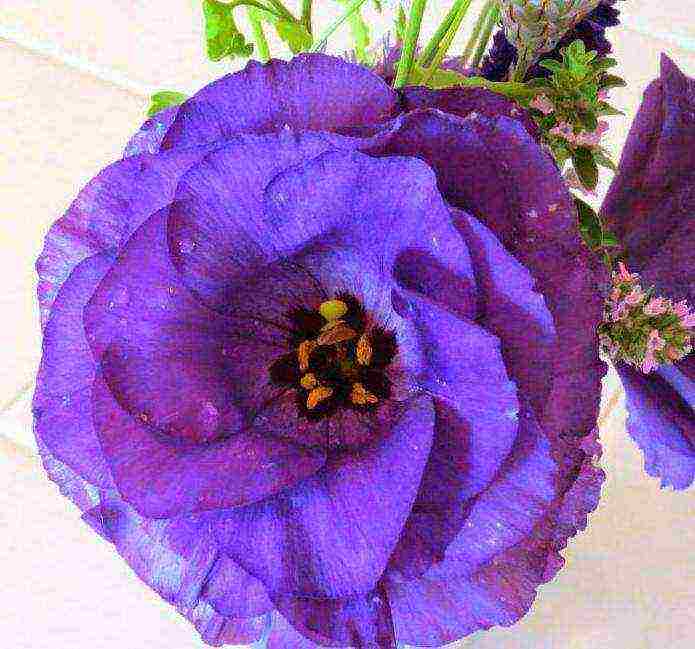 The prepared soil must be disinfected by any means and method. This can be hot potassium permanganate or steaming. If the planting is carried out in pots, then it is also necessary to disinfect them for them. Better to choose wide, spacious containers with good drainage holes. Planting seeds can be carried out in peat tablets, which can then be easily transferred to the main place. The pill container must also be decontaminated.
The prepared soil must be disinfected by any means and method. This can be hot potassium permanganate or steaming. If the planting is carried out in pots, then it is also necessary to disinfect them for them. Better to choose wide, spacious containers with good drainage holes. Planting seeds can be carried out in peat tablets, which can then be easily transferred to the main place. The pill container must also be decontaminated.
Pollination
Perennial eustoma, which is planted by the root in the form of already formed seedlings, in most cases, nevertheless propagates by seeds. To get a good seed, you need to carry out a simple pollination process. All you need is a soft brush. With its help, pollen is transferred from one plant to another. After a while, a box with seeds ripens. They are very small, but they are characterized by increased germination. Up to 15 thousand seeds can be obtained from one box. Once ripe, they will be ready for sowing.
Sowing
Eustoma (lisianthus), planting and caring for which require special conditions, is very moody. We plant seeds in prepared containers with soil and cover the pots on top with a film, creating the effect of a greenhouse. The optimum temperature for this stage is 25 degrees.
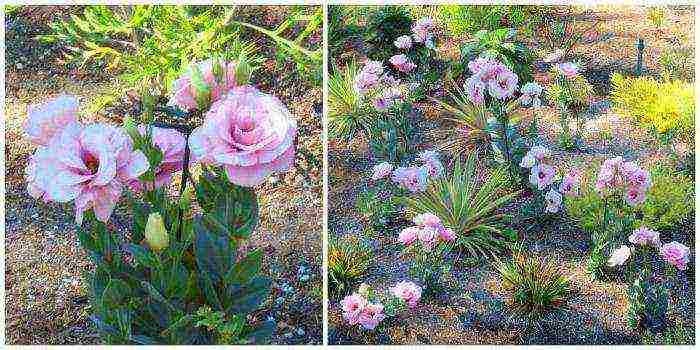 After two weeks, you can already observe the first shoots, which develop very slowly, which is the norm for this plant. Gradually, it is necessary to accustom the young shoots of a plant such as eustoma (lisianthus) to room temperature conditions. Cultivation and care, planting and selection of soil - all this is very important and requires a certain amount of patience and diligence. The plant is very thermophilic, therefore adaptation to the natural environment is necessary. This period will take about two months.
After two weeks, you can already observe the first shoots, which develop very slowly, which is the norm for this plant. Gradually, it is necessary to accustom the young shoots of a plant such as eustoma (lisianthus) to room temperature conditions. Cultivation and care, planting and selection of soil - all this is very important and requires a certain amount of patience and diligence. The plant is very thermophilic, therefore adaptation to the natural environment is necessary. This period will take about two months.
Picking
Seedlings should be planted in separate small pots, since up to 5-6 shoots can grow from one seed. After picking, we place the seedlings in a shady place, where the temperature should be about 18 degrees. As you grow, you will need another transplant into more spacious containers. Perennial eustoma, planting with the root of which must be carried out very carefully, has a delicate root system that is easy to damage.
We plant seedlings in the garden
Seedlings can be grown in a room on a windowsill or outdoors. How is planting and caring for eustoma in the garden carried out? To grow a beautiful plant, you need to create the right environment for it. Landing in open ground is carried out in May-June. At this time, the earth will already warm up enough, and the threat of frost will disappear. Eustoma is a thermophilic plant, and therefore should be planted in sunny areas.But at first, the seedlings need to be provided with shade so that it can adapt faster. The soil must be cultivated and nutritious. It is better to disinfect it before planting. Then a hole is dug to match the root system.
In such conditions, perennial eustoma will take root better. Root planting in spring is preferable, as the plant will be able to root well during the warm period. The seedling must be carefully removed from the pot without damaging the earthen lump with the root system and placed in the prepared hole. Then the free space is covered with earth. Do not press and compact the soil strongly, so as not to damage the roots and leave room for oxygen to access.
Eustoma is a moisture-loving plant. Therefore, care, first of all, consists in regular watering. The soil should not be allowed to dry out, but waterlogging will also not be beneficial. Loosening the soil around the flower is carried out with extreme caution. You can limit yourself to pulling out the weeds. Perennial eustoma loves only proper care. Rooting in the fall is more troublesome. The plant may not have time to take root until the first frost. This method is only appropriate in regions with warm climates or for growing in rooms and greenhouses. Eustoma loves moisture, light and warmth. Therefore, in room conditions, she needs to find a bright place with enough heat and spray regularly.
Breeding eustoma is a creative and painstaking process. The many varieties that are undoubtedly pleasing to the eye, allow you to decorate the garden and make it bright. Eustoma goes well with other plants, shrubs and flowers. It can be used to create compositions and decorate flower beds. This flower looks amazing in bouquets. That is why florists love it so much. And if we take into account the excellent property of eustoma for a long time to remain fresh even in the cut, then it can be called simply a universal flower. Caring for Lisianthus is difficult due to its capriciousness, but the result of the work will be amazing.
In this article, I would like to tell you and show you what perennial eustoma is - planting and care, photos of buds and inflorescences that simply amaze with their different shades. This delicate and at the same time luxurious flower has many names. The plant belongs to the gentian family, its homeland is Central America, but it is also very widespread in South America, Mexico - wherever it is quite humid and warm at the same time. She does not like drafts and sudden temperature changes (and what flowers do they like, if you think so?).
Eustoma, photo:

As for the names, they are no less attractive than the flower itself - "Irish rose", "Texas bell", "tulip gentian", "prairie flower". And yet, despite the fact that this botanical name of this genus is considered rather outdated, eustoma is also called lisianthus, which in Latin means “bitter flower”. Since this representative belongs to the gentian family, it is easy to draw parallels. Moreover, the plant itself contains many bitterness, such as gentianin, genseopicrin, genciamarin and other similar derivatives.
On the Internet, on the relevant flower forums and in groups, you can often come across the following question: eustoma and lisianthus - what is the difference? The answer is predictable - there is no difference, this is the name of the same plant.

If we briefly go into the details and origin of the names, then Eustoma - from the Greek "Eu" means: "beautiful", "beautiful", and the same Greek word "Stoma" - means "mouth". As a result, we get a "beautiful mouth" or "lovely mouth" - whichever you prefer.

It is interesting that in each country this flower is called in its own way: in Ireland - an Irish rose, in Japan - a Japanese one, in Mexico - it is generally called a Texas bell, in France - a French rose of love.Be that as it may, these poetic names correspond to reality and once again demonstrate the sympathy of many nationalities for this amazing flower.
↑ to content ↑ Features of the eustoma flower
It differs not only by names, but also by the colors of the buds, the shape of the flowers themselves. Representatives of a particular variety essentially resemble a rose. A person far from the world of floristry may even confuse them. Individual varieties resemble in size and shape poppies, terry mallows, some members of the lily family. Lisianthus stems are most often massive (as, for example, in a carnation), it is noteworthy that one shoot can accommodate 20 or even 30 flowers (and sometimes even more!).
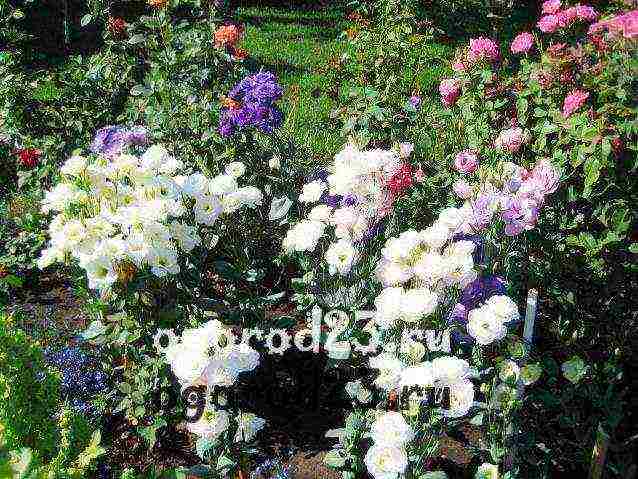
Eustoma - photo of flowers:

The leaves of the plant are not particularly distinguished, they are medium in size, slightly elongated with a sharp tip. But the color scheme of colors, as mentioned above, simply amazes with its multicolor. Red, blue, cream, snow-white, lilac, two-color - with a transition from one shade to another, pink, lilac, yellow - any shades can be eustoma-lisianthus! With its exquisite beauty, this flower can compete with the bride's bouquet - and it's not in vain! In addition to their visual appeal, these flowers are very durable when cut. Various celebrations, banquets are often decorated with her bouquets, decorative arches are made out. And all because they can not lose their freshness and beauty for 15 or 20 days (naturally, being in water or in a special wet floral sponge).
Irish rose differs in size, stem height. For example, depending on the variety, it can grow in the open field, in a greenhouse, in a pot on a windowsill at home (the so-called dwarf varieties). In its natural growing environment, this plant is a biennial, however, if you want to grow it in your summer cottage, count on the fact that you will have it as an annual. But potted versions of lisianthus are perennials.
Thus, perennial eustoma can exist exclusively in the home (apartment) version. The same factor applies to the length of the stems - tall representatives go to decorate bouquets and all kinds of decorations, and undersized lisianthuses delight your eyes at home, on window sills and flower shelves.
Lisianthus, by the way, is not quite capricious in cultivation and care. He will not require any special "dances with tambourines" even from a novice florist, both at their summer cottage and at home. Naturally, if you take this matter with interest and care, do not forget about watering, adhere to simple rules and recommendations of experienced florists or neighbors in the country, in whom it successfully grows and blooms.
↑ back to content ↑ Some popular varieties and types of eustoma
The main differences between these colors, of course, consist in the external difference of each variety, in colors and shades, a variety of forms. On flower forums, you can most often find references to the varieties listed below. I would also like to show them here.
Eustoma large-flowered Russell (Eustoma russellianum). It has a straight stem, the bud itself is somewhat similar to a poppy (in shape), the petals can be with or without fringe. It can have completely different shades of buds.
Eustoma Russell, photo:

Lisianthus Echo is probably the most common variety for bouquets. It can reach a height of 60 cm, and the color range of the buds has approximately 11 shades, both monochromatic and with a gradient (one shade, smoothly turning into another).
Echo variety, photo:

Lisianthus Aurora (Aurora) is an early cultivar, reaching 1.5 m in height, double flowers, saturated pink, snow-white, blue shades.
Eustoma Aurora, photo:

The Flamenco variety is a highly decorative species of Lisianthus, also reaching a decent height (about 1.3 meters). It is very unpretentious to care for and also boasts a multicolor bud.
Flamenco variety, photo:

Florida Pink has pink flowers! At least here it is not difficult to get lost in the bright variety. This is a perennial, the shoots of which are abundantly covered with flowers.
Lisianthus Florida Pink, photo:

The variety "Mermeid" is a potted species with a stem height of up to 15 cm. It is presented in a predominantly blue-violet range (mermaid-sea associations), but sometimes pink and white representatives are also found.
Mermeid variety, photo:

The Little Bell variety may seem rather simple in appearance, especially against the background of some lush fellow tribesmen, but this is precisely its charm and touchingness. It is also suitable for potting.
Lisianthus Little Bell, photo:

White Large-flowered (Lisianthus grandiflorum) is probably one of the most impressive varieties. This is exactly the eustoma from which wedding bouquets are made and with which they decorate the interiors of banquet halls. A very impressive and luxurious variety.
Lisianthus grandiflorum, photo:

In fact, there are about 60 varieties of this flower in nature, all of them are at the same time somewhat similar, but, at the same time, they are completely different in appearance.
↑ to the content ↑ Features of growing eustoma in the garden, collecting seeds
In order for this beauty to feel comfortable and bloom in a violent color on your site, you need to decide in advance on the landing site. It should be sunny, and the soil on it should be fertile. Watering lisianthuses should be done as the upper layer of soil dries up.
Top dressing and fertilization is a matter of course, as in the case of any flowering garden dweller. This flower should be fertilized when it has already firmly rooted in a new place, this happens about a month after the seedlings are transferred to the flower bed (in open ground). According to experienced florists, lisianthus prefers special complex preparations, similar to those recommended for the vast majority of their flowering counterparts.
How to grow eustoma? Top dressing "Plantafol Growth" or simply "Plantafol" is applied at the very beginning, when the flowers require fertilizers with a high concentration of nitrogen. When they begin to form buds (about mid-summer / August), you can begin to add Plantafol Budding to the root - it contains much more phosphorus than nitrogen. Preparations "Kemira" or "Kemira Lux" will contribute to a longer and more luxuriant flowering. The main thing - do not forget that all such additives must be diluted with water. And, one more important nuance, which is not indicated on the fertilizer package, but is strongly recommended by experienced flower growers - dilute a slightly lower concentration of fertilizer in water than is written in the instructions for use!
The Irish rose begins to bloom in mid-summer (July) and continues to delight the eyes with lush buds until mid-autumn (until about October). As mentioned above, this flower is quite "tenacious", both in cut and in natural form - lisianthus inflorescences on one shoot may not fade up to 2 months. If you carefully cut the twig, it will grow back and be covered with new flowers. The duration of flowering also depends on the growing region: the warmer it is in your area, the longer it will bloom. For example, in our Kuban lisianthus will bloom for a long time and will repeatedly give new buds!
Eustoma - photo of flowers:

↑ back to contents ↑ How to collect eustoma seeds
Now let's get to the more serious part of the growing process - collecting seeds and further manipulating them. The seed pods of the flower are formed after pollination. In the open field, of course, plants are pollinated by insects.If you are breeding Lisianthus at home, then solving this problem with an ordinary (soft) brush will not be difficult and will not take much time. As with other flowers, seed pods remain in place of dried buds that have not been removed from the shoots.
Planting eustoma with seeds almost always has a positive result. The seeds sprout pretty well, both those that you managed to collect yourself and those that were purchased from the flower shop.
They are very small in size, those that are sold in the store are already "rolled up" in a special thin shell, which consists of components that promote better plant germination and growth. It is most convenient to stock up in advance with special cassettes for seedlings, and even better - peat tablets! In these tablets, the soil mixture has already been selected with a competent calculation of the composition, and it is much more comfortable to plant these tablets later in open ground. And there - see how it is more convenient for you.
Eustoma seeds, photo:

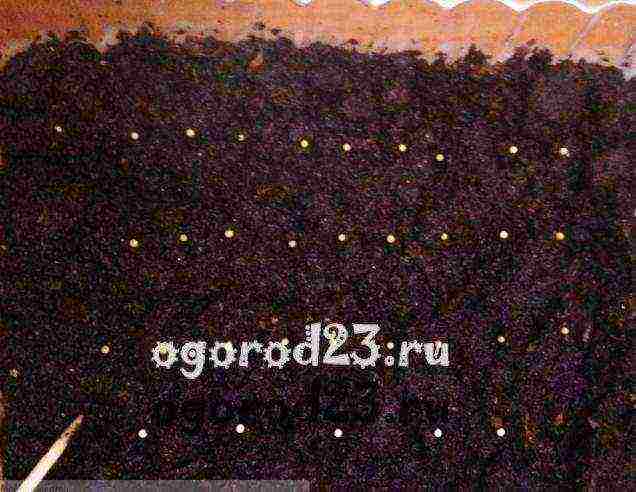
Both purchased store-bought and self-collected seeds are most conveniently buried in the soil with a toothpick, as shown in the photo above. Seeds are sown in winter or at the very beginning of spring - most often in February or early March, but there are also frequent cases of successful planting in January.
↑ to content ↑ Eustoma - growing from seeds
As mentioned above, for convenience, saving time and effort, you can buy peat tablets, you can also buy a ready-made soil mixture in a flower shop (the one that is designed for planting Saintpaulias or violets is perfect).
At the same time, you can approach this process in detail and make up the soil mixture yourself. At the time recommended for sowing, take a light garden soil that should pass water and air well. It should be clean land from a garden plot (without any plant residues or stones), peat and calcined river sand. Put all these components together in equal proportions. Additionally, you can add a couple of tablespoons of wood ash.
To play it safe and be sure that the sowing will be done in a clean earthen mixture, decontaminate the soil - this can be done by spilling the soil with a solution of potassium permanganate or steaming (not roasting in the oven!) a quarter is filled with water, put on fire. From above, earth is poured into a colander and covered with a lid on top. The whole process takes about 1 hour. The hot steam from the water flows through the holes in the colander and kills any bacteria in the soil. However, this method has one drawback - with harmful bacteria, beneficial microorganisms can also be destroyed that help resist future plants. In any case, the choice is yours. Subsequently, the steamed soil will have to be saturated with useful biofungicides, such as "Fitosporin" or, for example, "Trichodermin", "Baikal M1".
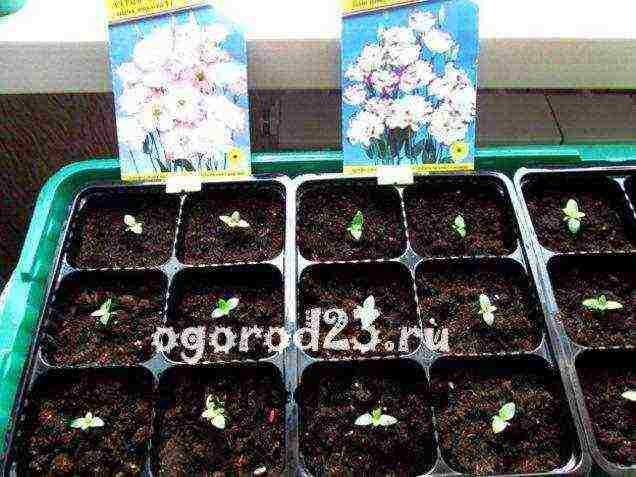
It is also extremely important to consider that sowing should be done only in disinfected containers! It can be like cassettes for seedlings (they can be seen in the photo above), ordinary plastic or paper cups. Drainage holes are required for any containers you choose. Not only the soil mixture, but also the pots must be treated with appropriate disinfectant solutions. Even the container for peat tablets should be decontaminated as well.
How eustoma is planted with seeds:
- We take containers and fill them with a moistened earthen mixture.
- We put the seeds on top (you can use a toothpick or a sharply sharpened match - for convenience), do not deepen it much, just press it a little into the soil.
- Sprinkle with water from a spray bottle.
- We cover the containers with plastic (or thin food) film so that it must transmit light.
- Then the seedlings are transferred to a bright, warm place with an average air temperature of + 20 .. + 25 ° C. Advice - a south window is perfect for this. Sometimes it happens that the usual daylight hours are not enough for the harmonious development of plants. In this case, fluorescent lamps will come to your aid (i.e. supplementary lighting of seedlings). It is important that the plants do not start to stretch out from the lack of light!
- Once a day, briefly lift the film and ventilate the seedlings, along the way, gently moistening the soil with a spray gun.
- With the onset of night, you can move the containers to a cooler room, but with a not too significant temperature difference - this is not a prerequisite, but with the right approach it will not be superfluous.
If you do everything right, then the first small sprouts will appear in 10-12 days. After the eustoma-lisianthus has shown itself to the world, the protective film should be removed, irrigation should be moderated, the containers with plants should be transferred to a cooler room - with an air temperature of about +15 .. + 18 ° C. This flower is gaining growth slowly, the first true leaves appear after about a month and a half. By this time, it is already worth thinking about diving, although it is usually done two months after sowing.
Eustoma seedlings in the photo:

About diving:
- Before diving, water the soil in containers with plants.
- The fact is that even one seed can give 5 or 7 shoots, therefore, at a given time (2 months), the best, strongest representatives are selected, after which it should be very carefully, using a suitable miniature object, to remove the sprouts from the ground, and then transplant in individual pots or, again, in cups.
- Do not forget about drainage - pour a thin layer of fine expanded clay or even foam balls on the bottom of the pot.
- Deepening in the soil mixture can be done using an ordinary pencil, and the "operation" of the transplant itself using a metal manicure spatula, for example.
- Lisianthus seedlings have a very delicate root system - remember this always, not only at the time of transplanting.
- In the process of diving, bury the plant into the ground up to the very leaves.
- After that, it is advisable to place the containers with flowers in a shaded place, where the air temperature will be approximately +18 ° C.
In most cases, lisianthus tolerates the picking process very comfortably, so the adaptation period in a new place is successful and the plant begins to grow rather quickly. After two or three months (as the weather in your region will allow), the Irish rose is transplanted to a permanent place of residence - either in a room pot, or on a flower bed, a summer cottage. This must be done carefully, by the transshipment method, together with the earthy lump - there is nothing new here. For this process, it is better to choose late spring / early summer, when any frost is 100% excluded.
Lisianthus after a pick, photo:
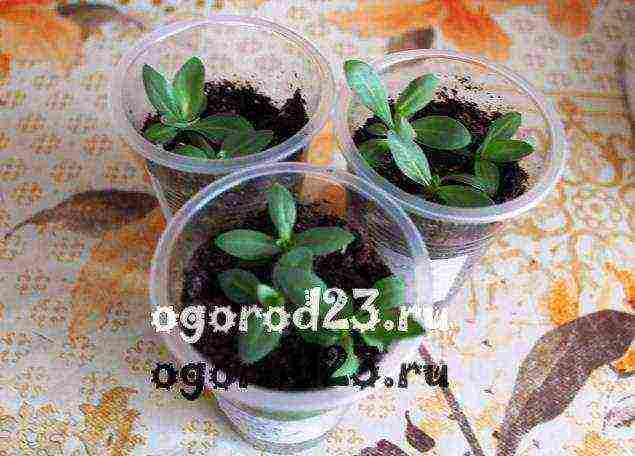
↑ to content ↑ How to grow eustoma in peat tablets
If we pay attention to the method of planting Lisianthus in peat tablets, then, I repeat, it is undoubtedly more convenient in all respects. Just take tablets of the appropriate size - for this plant you need a "circle" with a diameter of at least 5 cm. Further, I think, you will figure it out according to the instructions - the tablet is moistened with water at room temperature, swells to the required size, excess water is removed. The seed with the help of tweezers or a toothpick is placed in a specially designed hole, slightly pressed, and irrigated with water from a spray bottle.
Eustoma - cultivation in peat tablets, photo:
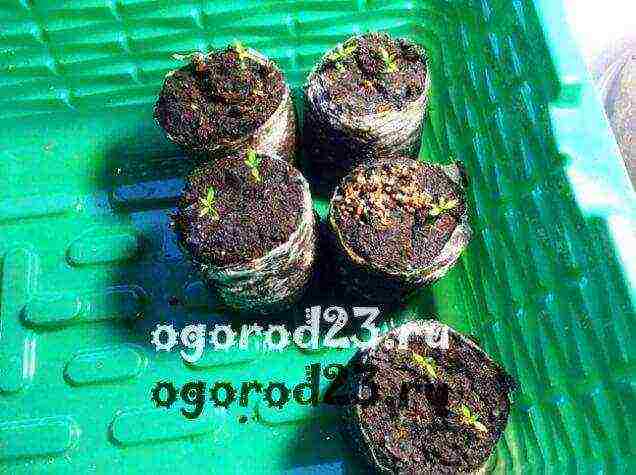
Then, too, everything goes as usual - covering with a film (creating a kind of greenhouse), airing, placing in a warm and bright room. Everything is the same as in the case of planting in soil. But when the first small leaves appear, immediately put the pill in a plastic cup.Thus, the roots will not intertwine, and each Lisianthus will be in its place.
↑ to the content ↑ Eustoma lisianthus - we plant it in the ground
We already know that it is preferable to choose an unshaded place on the site. About the absence of winds and drafts - too. For planting in open ground, choose a cloudy day or evening after sunset. The month is May or June, when sudden cold snaps will definitely not come. To release the plant from the pot, we use the transshipment method (remember the delicate root system of the eustoma). The distance between the bushes should be approximately 20-25 cm.
An Irish rose lisianthus is placed in a previously prepared hole along with a lump of earth, lightly sprinkled with soil and carefully squeezed. The hole itself should correspond in size to the size of the pot in which the flower grew. Its volumes should freely accommodate the extracted plant along with an earthen clod. By the way, additional protection of Lisianthus at the beginning of life "on earth" will not be superfluous - on a sunny day, cover the bushes with glass jars or cut plastic bottles. Eustoma blooms regardless of which month of winter or early spring you sowed the seeds. Around the middle of summer, in July, you can see the first flowers of this delicate and graceful flower.
↑ back to content ↑ Perennial eustoma - root planting
Due to the fragile and vulnerable root system, this plant cannot be propagated by dividing the bush into fragments or by cuttings (they do not germinate). As a last resort, ready-made seedlings can always be purchased in the appropriate flower shops. It reproduces only by sowing seeds, by growing seedlings - and nothing else. Lisianthus roots do not tolerate replanting, any sudden or incorrect movement can ruin the plant!
Sometimes it happens that novice growers under the concept of "Perennial Eustoma - planting by the root" mean precisely the division and subsequent planting of separated roots. Here it is necessary to clarify this small misconception, under the phrase "planting by the root" is often used the usual action of transferring a plant into open ground with a "native" earthen lump and, naturally, roots formed in it. These two concepts should not be confused.
↑ to the content ↑ Eustoma - when to sow seedlings in apartment conditions?
To grow this flower at home, sowing seeds can be done whenever you want! Eustoma seeds are tugovidny, so it is better to sow them on the growing moon. Suitable dates can be viewed in the moon phase calendar by month.
The main thing is to remember all the nuances, temperature conditions, backlighting (especially in winter) - and you will succeed. For potting at home, low-growing (dwarf) varieties of Lisianthus are used. The plant will feel more comfortable on those windows that face the east or west side. Bright, slightly diffused lighting is what is needed for a room eustoma, but on the south window, especially at noon, it is better to arrange light shading. It is highly likely that on the north window the Irish rose will not be able to develop harmoniously and may wither away from lack of sunlight. If you purchased a ready-made flower in a store, give it time to adapt, do not expose it immediately to direct sunlight, so that the leaves and flowers do not burn.
Make sure that when watering the water does not get on the flowers and buds, otherwise decay will not take long. In general, when watering, try to adhere to the golden mean - do not let the soil dry out, but also do not overmoisten it too abundantly. The optimal soil condition for irrigation at home is the formation of 1.5-2 cm of a dry upper layer of soil mixture in a pot.There should always be drainage in containers for a given plant; fine gravel, clean disinfected small pebbles or fine gravel can be placed on the bottom. In general, according to observations, homemade eustoma-lisianthus gives flowers best and feels comfortable in a slightly cool, well-ventilated room.
↑ to the content ↑ Caring for eustoma - recommendations
Adding to the above, we can recommend preventive irrigation procedures with special agents containing fungicides. Preparations "Topaz", "Saprol", "Topsin" will protect the plant from powdery mildew, fusarium, leaf spot, gray rot. Unfortunately, it is difficult to protect yourself from pests if the flowers grow outdoors. The main enemies of eustoma are whiteflies, slugs, aphids, miners, mushroom mosquitoes - such drugs as Mospilan, Aktara, Confidor and the well-proven Fitoverm successfully fight against these parasites.
Remember the love of Lisianthus for light and light shade, the east or west sides of the site are the best places for its growth. Water it sparingly, but regularly, do not wet the foliage when watering, so as not to provoke the appearance of gray mold and harmful fungi. Irrigation is no longer needed for an adult flower, and water for irrigation, ideally, should be soft or settled. When the air temperature drops, the volumes of water for irrigation should be reduced. Sometimes, after planting in the ground, some gardeners recommend covering the plants with large plastic cups or cut plastic bottles for the first couple of weeks. This is recommended for the adaptation of the flower, getting used to a new place of residence, protection from drafts and winds, as well as to retain moisture in the upper layer of the soil.
After the eustoma-lisianthus fades, it begins a dormant period, life processes slow down and the plant seems to "fall asleep", stops growing. By this time, fertilizers should be completely eliminated, watering should be minimized, in a word - to give the flower a rest. In order for the Irish rose to delight you with its splendor next year, be sure to cut off all the branches, leaving at most two or three main points of tillering (branching).
↑ to the content ↑ Eustoma - growing, summing up
Wherever she grows up, she needs to create a comfortable environment. On the site or at home, in the room - it should be good, then it will bloom and smell, please you with a healthy look. This plant is capable of producing flower stalks throughout the entire flowering period, if the shoots are not cut at the root. But in warm regions, even such radical pruning can lead to the re-development of stems and flowers on them.
Perennial tall eustoma will decorate your site and the surrounding area, it will harmoniously combine with other flowers and shrubs, will remain fresh for a long time and will perfectly tolerate transportation in a cut form, if the situation requires it. Low-growing varieties will become a bright decoration of your home, balcony, window sill.
It must be remembered that the Irish rose is a plant that will inevitably wither away without moisture. Drying out of the soil should not be allowed in any case. Excessive waterlogging will also not lead to anything good - the plant will begin to hurt, the roots may rot. Push the ground around the flower carefully (remember the delicate roots), we naturally remove the weeds.
Reading, getting acquainted with all the nuances, it may seem that this is too troublesome business, and the lisianthus eustoma itself is a capricious and characteristic plant. In fact, this is not at all the case, any green resident we cherish and cherish requires attention and care, sometimes individual. Trees, shrubs, any plants and flowers are creatures of nature, they are alive and also need comfortable living conditions.And the beautiful eustoma is not so different in terms of avoiding her neighbors with roses, fragrant hyacinths, surfinias and other decorations of our gardens and plots. There is hardly a florist or summer resident who does not like perennial eustoma with its delicate beauty, planting and care, photos of various varieties and shades will not leave anyone indifferent!

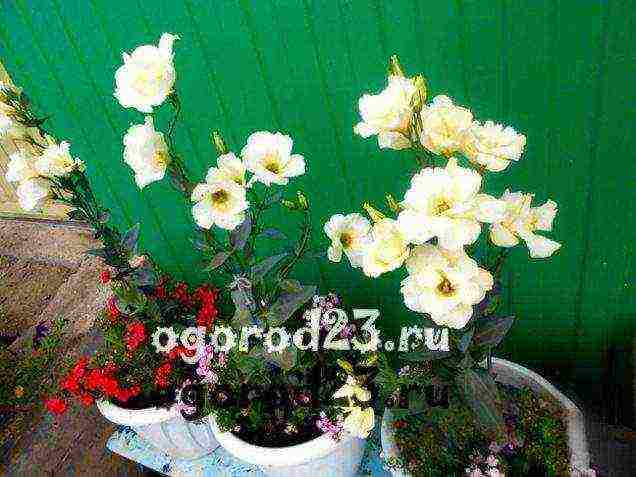
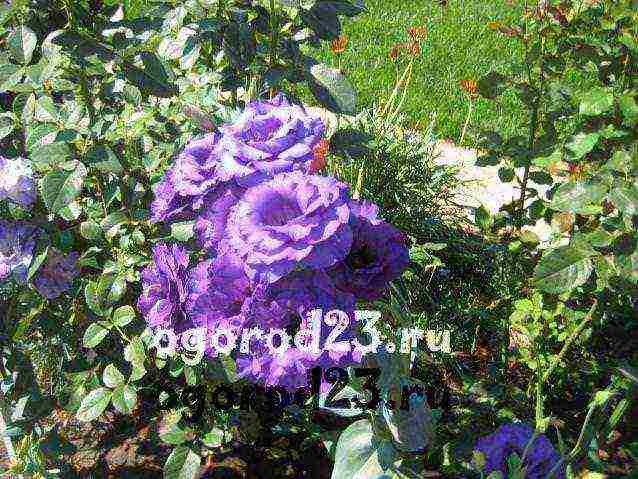

Irish rose, elegant and refined eustoma, has known both periods of universal admiration and almost oblivion. But today she is again popular and loved. This plant is grown primarily for cutting. Beautiful flowers, reminiscent of delicate silk half-open roses, stand in bouquets for a long time. A wide palette of colors, the tenderness of a flower with amazing durability always surprise. As well as the complexity of growing a plant that requires a special approach to itself. Eustoma is grown both as a garden, as a greenhouse, and as an indoor culture. And in any capacity, the plant will require very careful care.
Also known among flower growers as Lisianthus Russell, Irish, Japanese rose, Texas bell or love rose, eustoma is one of the most beautifully flowering crops. Both in gardening and in floriculture, it is represented by only one species - eustoma large-flowered (eustoma grandiflorum).
Earlier, in the genus Eustoma, three separate species were distinguished. However, the joint work of the staff of the Royal Botanic Gardens in Kew (Great Britain) and the Missouri Botanical Garden (USA) to streamline the nomenclature of modern taxa of plants, combined the following species under a single name - Eustoma grandiflorum: Eustoma grandiflorum, Lisianthus - Eustoma Russel, or Russell (Eustoma russellianum), Eustoma small, Gentian small, Western gentian, Blue marsh eustoma (Eustoma exaltatum).
Large-flowered eustoma is a luxurious plant with a height of 30 to 90 cm with branched shoots, simple, elegant leaves with a bluish tint and flowers reminiscent of a hybrid of a rose and a poppy. Up to two dozen large, luxurious flowers bloom on one plant per season, and due to the fact that they do not open simultaneously, but in turn, eustoma retains its attractiveness for an amazingly long time. The ability of the buds to bloom after the withering of the flowers is also preserved in bouquets: buying an eustoma or displaying it in vases, you can be sure that each bud will turn into a beautiful Japanese rose. Each plant looks like a bouquet: due to the specific branching, strong, but slender, fan-shaped, the eustoma really seems to be a bouquet planted in a pot.
Eustoma bloom depends on the timing of sowing and begins 20 weeks after sowing. In classic garden eustomas, it starts in June-August and lasts until mid-autumn, because the plant will not stop delighting with flowers until the frost reaches -10 degrees and snow falls.
Bouquet of eustoma
The color palette of eustoma today includes not only white, purple, pink, yellow, orange colors, but also various two-color and watercolor combinations. Compact indoor eustomas have colors that are usually clean and bright enough, while garden ones have a much wider range of colors. It even includes light green, fruity shades.
The huge assortment of eustoma and its popularity all over the world is the merit of the breeders of the USA and Japan. In the west, this plant is one of the most popular cut species, but in our country this Japanese beauty is slowly gaining ground.
Different approaches to growing eustoma
The rose of love is a truly exclusive plant. And its special status of “a flower not for everyone” is fully justified. After all, growing eustoma is really not easy. There are 3 different growing strategies for eustoma:
- in room culture;
- in the garden;
- in greenhouses or greenhouses as a cut plant.
The agrotechnology of growing eustoma in the garden and in greenhouses is no different.Most often, the plant is cultivated as an annual, simply discarded after the magnificent flowering season. This approach has a definite plus: it is the annual eustomas that can be made to bloom most abundantly. Growing as a perennial requires indoor winter maintenance, because eustoma does not tolerate frost. If you have the opportunity to transfer the eustoma, place it, then it will delight you with magnificent cut flowers from year to year. True, there are some nuances here: many growers notice that eustoma does not cause trouble and pleases only 2 years, and from the third it begins to hurt, be affected by pests, gradually withers away. So there are only two options for growing it - as an annual or a biennial.
As a houseplant, eustoma is just beginning to gain popularity, it is quite rare. And in this capacity, only eustoma with a minimum height, dwarf varieties, can be cultivated.
A kind of intermediate option - growing as a garden potted plant. It allows you to achieve the main thing: to get rid of the need for digging for the winter, because the pots just need to be moved indoors. But there are also some other benefits. In particular, easier control over conditions and humidity, the ability to adjust lighting without problems. In terms of conditions and care requirements, indoor and potted eustomas are identical.
Eustoma, cultivar 'Echo Pink'
Growing eustoma in the garden and greenhouses
The agrotechnology of growing Irish cut roses is similar when planted in protected conditions of greenhouses, and in open soil. After all, temperature preferences, like other requirements for plants, do not change.
Conditions required for eustoma in the garden
Both in the garden and in the greenhouse, the eustoma must be provided with the brightest possible lighting. Diffused light will suit the beauty as well as the brightest sunny locations. Even in the slightest shade, the eustoma may not bloom. It is better to protect a sissy eustoma from drafts, and even more so from cold winds.
The soil for the plant is also far from suitable. The soil should be well cultivated, improved, dug deep. Eustoma can only grow in water and air-permeable soil, which does not create the risk of stagnant water and waterlogging. Loose, light, with a high percentage of organic matter and certainly fertile soil is the main guarantee of success in growing eustoma.
Planting eustoma in the ground
Before planting eustoma, it is necessary to improve the soil. Double digging with the introduction of humus, compost, a portion of full mineral fertilizers will be a sufficient measure for this culture. If the soil is too wet, there is even the slightest risk of waterlogging, then it is better to lay new drainage under the ridge.
It is important to plant eustoma after the slightest threat of frost has disappeared, not earlier than the end of May for the garden and April in greenhouses. At the same time, the planting time itself also matters: eustoma prefers planting in cloudy weather or in the evening.
The eustoma is planted in the soil so that a distance of 15-20 cm remains between the plants. The level of burial during planting should be the same as that of the seedlings. It is impossible to destroy an earthen lump. Watering is carried out immediately after planting, and then stable conditions are maintained until growth resumes. If the eustoma is grown for cutting, then it is better to place the newly planted plants under a hood for several weeks.
Wild form of eustoma
Garden and greenhouse eustoma care
Japanese rose is very demanding to care for. It is sensitive to changes in humidity, top dressing, and gratefully reacts to an increase in air humidity in greenhouses (by any method, except for spraying).
Irrigation for eustoma should be systemic, but regulated in accordance with the frequency of precipitation and temperature. Waterlogging of the soil should not be allowed. But a prolonged drought will also lead to a disruption in development.Light, stable humidity, more frequent watering on hot days and during drought is the ideal strategy for the rose of love.
Top dressing is applied with full mineral fertilizers. After all, eustoma needs the same amount of nutrients, nitrogen is just as important for it as phosphorus with potassium. Traditionally, feeding is carried out monthly for eustoma in an annual culture, 3 times (active growth, budding and the beginning of flowering) for eustoma, which is preserved for the winter. When grown for cutting in greenhouses, the tactics with nitrogen fertilizers before flowering and potassium-phosphorus fertilizers after budding are sometimes used.
This plant will gratefully respond to soil mulching, which will significantly reduce irrigation and stabilize growing conditions.
In tall eustomas, shoots are often too thin, weak, they need support. At the first signs of lodging, breaking of twigs, the plants need to be tied to a peg or pulled rows of twine for large plantings.
Eustoma, ‘Borealis Blue’ and yarrow ‘Moonshine’
Wintering garden eustoma
Usually, pot eustomas growing in the garden are preserved for the next year, but you can also carefully dig up soil plants, transferring them with an undisturbed earthen clod to pots. In eustoma, before wintering, shoots are cut off, leaving 2-3 internodes on them. Under the condition of minimal, meager watering, lack of fertilizing and bright lighting, eustoma should winter in rooms with a temperature of about 10-15 degrees Celsius. The usual care is resumed only when new shoots appear on the plant. In a heated greenhouse, wintering conditions are similar.
Pest and disease control in the garden
Eustoma does not belong to resistant plants. It attracts spider mites, slugs, whiteflies, which are best dealt with immediately with insecticides. And from diseases she is afraid not only of gray rot, but also powdery mildew with fusarium. To avoid the risk of infection, it is best to carry out preventive spraying with fungicides.
Growing eustoma as a house or garden pot plant
The opportunity to cultivate luxurious eustoma as a purely indoor plant appeared relatively recently. And we are completely indebted to her to Japanese growers who have developed special varieties of eustoma that feel good in pots. 10-20 years ago, eustoma in the assortment of indoor plants was a miracle, and they were brought into the premises only to save for the winter for the garden. It is better to buy indoor eustomas not in the form of seedlings, but ready-made formed bushes in specialized flower shops. If you are looking to purchase multiple specimens along with your garden seedlings, make sure you are offered a variety specifically suited for potting. The height of indoor eustomas is limited to 15-30 cm.
Even modern hybrid indoor eustomas are grown as seasonal annuals, plants that, after colorful flowering, are easier to throw away than try to preserve in a perennial culture. If you arrange a full-fledged wintering for the eustoma, provide super-difficult care and cool temperatures, then the plant can be grown as a biennial, but the eustoma will not become a full-fledged perennial. Another unpleasant "surprise": indoor eustomas usually grow rapidly after purchase, increase in size due to treatment with growth inhibitors.
For growing in a pot culture with a stay from late spring to autumn in the fresh air in the garden, only eustomas of sufficiently compact sizes are also suitable. Usually on sale you can find seeds and seedlings, which indicate that they can be used for container growing. Such densities can be grown both as annuals and as perennials, especially in pots or with planting in the ground for the summer.
Lighting and temperature control
Lighting for indoor and potted eustoma should be light, bright, but direct sunlight should not fall on the plant.On a sunny location, both the leaves and flowers of the eustoma will suffer, the plant may react too sensitively to violations of the comfortable level of humidity.
But the temperature regime is easier to choose: in the warm season, the eustoma will feel comfortable in ordinary room temperatures, and potted forms - in the fresh air in the absence of temperature drops to 10 degrees. If you do not want to throw away the plant and try to save it in winter, then after flowering and before active development begins, the eustoma should be placed in cool conditions with a temperature of about 10 degrees Celsius for indoor crops and 10-15 degrees for potted crops. Wintering lighting should not change.
Watering and feeding for eustoma
Caring for eustoma in indoor and pot culture should be meticulous, but not too difficult. This beauty is watered so that the substrate remains slightly moist all the time, without drying out, but also without excessive moisture. Between procedures, the top layer of soil (3 cm) should dry out, and it is advisable to drain the water from the pallets immediately after watering.
Top dressing is used only from the number of fertilizers for flowering plants, in a standard dosage every 2-3 weeks for any form of cultivation. With cold wintering, all watering is reduced to minimal, and no fertilizing is carried out. It is strictly forbidden to spray the plant, but the increased humidity will benefit the eustoma (it is provided by arranging trays with wet moss or humidifier devices).
For eustoma, only warm water is used: the temperature contrast between the ambient air and the substrate can be destructive for both indoor and garden potted eustomas.
Eustoma in a pot
Transplant and substrate
To stimulate the flowering of eustoma next year, after the plant wakes up, you need to immediately transplant. The eustoma is moved to a new substrate, if necessary, increasing the pot by only a few centimeters. For eustoma, slightly acidic or neutral soil mixtures with a loose, light, permeable texture are suitable, to which a large amount of fine sand is necessarily added. For this culture, the substrate for Saintpaulias is perfect. A powerful drainage layer must be laid on the bottom of the container. But the main thing is not to destroy the earthy lump during the procedure, and even more so not to divide each eustoma bush, because the plant will not survive even the slightest injuries of the rhizome.
Diseases and pests
Indoor eustomas suffer less from typical diseases, but at the slightest violation of the comfortable moisture of the substrate, they are quickly affected by gray rot. Whiteflies and thrips are both dangerous for these beauties. At the same time, the inspection of plants for the earliest possible detection of the problem should be carried out as often as possible, and it is better to start the fight immediately with the help of fungicides and insecticides.
Potted garden eustomas are as vulnerable as those growing in soil.
Pruning eustoma
In fact, all potted eustomas only need a pinch at the seedling stage. But if the plant is saved for the next year, then it is cut off before being cleaned for storage, leaving several internodes on each shoot.
Cut for bouquets
Eustoma flowers are cut when at least a few “roses” open. You should not be afraid of pruning: the eustoma is able to bloom again, is actively developing and, on average, pleases with new inflorescences after 4-6 weeks. The same technique can be used for poor, very short flowering: by pruning, you can re-stimulate flowering in garden eustomas.
Variety of eustoma colors
Reproduction of eustoma
Despite the fact that eustoma reproduces both vegetatively and by seeds, only the sowing method can be used on a private scale. Eustoma cuttings are very difficult to root, they need specific and strictly controlled conditions, and this option is usually left only for selective purposes.
Eustoma has one key feature that complicates all agricultural technology: the seeds of this plant are ultra-small. 1 g contains about 15000-25000 seeds, and if you do not want to buy ready-made eustoma seedlings, but grow this culture yourself, then it is better to immediately choose granular seeds. They are easier to handle and the seeding frequency is much easier to control.
Eustoma seeds are sown in mid-March. But if you want to get flowering bushes in the middle of summer, and not in August, then sowing should be postponed to February and even January. If the plant is grown in a room culture, the sowing time can be shifted depending on the desired flowering time (for example, for flowering during the winter, you need to sow eustoma at the end of July, August or the very beginning of September).
Only sterilized soil can be used for this plant. Unlike most annuals, eustomas are sown not in a common container, but in small pots with a good drainage hole, allowing bottom watering. Seeds should be scattered on a pre-moistened substrate without covering. Germination is carried out at a stable temperature of 23-25 degrees Celsius (a drop to 18-20 degrees at night is permissible). Every day, the crops are ventilated in the morning and evening, and a stable light humidity is maintained by bottom irrigation or spraying.
The germination process takes about 2 weeks, but at the very beginning of development, eustomas grow very slowly. To protect against blackleg during this period, it is better to spray the seedlings with phytosporin, and in order to avoid disturbances in the development and loss of plants, protect young seedlings from direct sunlight. The pick is carried out in individual containers only when 5-6 leaves appear. After transplanting, the plants are carefully watered, and from the tenth day from the pick they are introduced into the feeding program with full mineral fertilizers. After releasing 7-8 leaves, the top must be carefully pinched to thicken the bushes.
Eustoma seedlings are transferred to open soil or garden pots only when the threat of return frosts disappears, not earlier than the end of May and the beginning of June.
When grown in a greenhouse or conservatory, sowing can be done directly into the soil. Seeds are rarely scattered, and then the seedlings are thinned so that a distance of 15-20 cm remains between the plants.When sowing in the ground, the temperature is critical:
- if germination took place at standard 23-25 degrees, then the eustoma will bloom in the same year;
- if the temperature was higher, then it will only form a beautiful rosette of leaves, but it will bloom like a biennial, only in the second year of cultivation.
Varieties and their features
Lisianthus happens:
- One-year, two-year, or perennial.
- With double or non-double flowers.
- Dwarf (up to 30 cm tall, for breeding in an apartment) or tall (for a garden, for cutting).

Popular varieties. Low-growing:
- Mirmaid - up to 14-15 cm high, non-double flowers 7 cm in diameter. The petals are pink, white, blue, purple.
- Loyalty - up to 20 cm, white flowers are arranged in a spiral.
- Florida Pink - can grow up to 25 cm, bloom profusely, a wide range of shades.
Tall varieties:
- Aurora - 100-120 cm, with double, blue, pink or white petals. Differs in early flowering.
- Echo - up to 70 cm, bush well, large flowers, monochromatic and two-colored.
- Heidi - up to 90 cm, 15 colors, abundant flowering.
How to properly plant eustoma in open ground 1. Choice of planting time
Seedlings are planted after the end of the last frost, in late May or early June, when the stem reaches at least 10 cm in height. Ideal conditions are dark or cloudy weather, the air temperature is not lower than 18 ° C and not higher than 20-21 ° C.
2. Site selection and soil preparation
A place for landing is selected sunny (preferably diffused light) and protected from cold winds.
The soil should be:
- Well crafted and dug up.
- Breathable.
- Sufficiently moist, but without waterlogging, as this leads to root rot.
- Fertile, with a high amount of organic matter.
- Black soil is best suited.
3. Treatment and preparation of soil
Compost, mineral fertilizers, humus from bark and peat are added to the soil, double digging and drainage are done if the soil is excessively wet.
The soil should have enough phosphate for root growth, nitrogen and potassium in a 2: 1 ratio. Periodically loosen the soil around the planted flower.
4. The process of planting in open ground

- Saplings are planted by transshipment, with an earthen clod in pre-dug holes with warm water.
- A distance of 15-20 cm should be maintained between future bushes so that they grow freely.
- For adaptation, the seedlings are covered - usually with half a plastic bottle, a jar or film on the frame. At this time, watering can be omitted. When the flower grows stronger, the shelter is removed.
- For the development of the root system, watering of a rooted plant is reduced, stimulating it to look for moisture in the soil;
- When the flower grows to 8-10 leaves, its top is plucked for better branching.
- During flowering, so that new buds form without interference, faded stems and peduncles are immediately removed. When the plant fades for the first time, it is pruned so that new branches appear and the eustoma blooms again.
- To support the thin stems, they are tied to pegs or another support frame, such as a rope, is pulled.
Reproduction
The eustoma has a fragile, fibrous root system. Reproduction by division almost always kills it. And planted cuttings take root with difficulty.
These flowers are usually propagated by seed. They spray well and produce capsules with small, excellent germinating seeds. When the plant has faded, the seeds can be collected and placed in a dry place to dry out. They can be planted next year.
It is better to germinate seeds at home:
- Plants intended for the garden begin to be planted at the end of January - mid-February, so that the bushes have time to bloom in the summer - from mid-July. Indoor low-growing eustomas are planted at any time of the year. The time between germination and flowering is approximately 5-6 months.
- Comfortable temperature - 20-21 ° C during the day and 15 ° C at night. Temperatures that are too high cause outlets to appear.
- Sow in a sterilized, well-drained substrate, with a low nitrogen content and neutral acidity of 6-7. For example, a mixture of humus from bark, peat, washed sand or garden soil. Mixtures for Saintpaulias or violets are suitable, with the addition of a small amount of wood ash.
- First, drainage is laid (for example, from expanded clay) with a layer of several centimeters and the container is filled with a substrate 2 cm below the edge.
- The seeds are scattered on the ground and slightly pressed down (but not buried), then cover with foil or glass, leaving ventilation holes.
- Eustoma grows better in light, with a lack of it, some of the buds may not grow or fall off. To grow a flower, choose a balcony on the light side of an apartment or special shelves with lighting or illuminate with fluorescent lamps. But you can not put in direct sunlight.
- The first shoots appear in 7-14 days. To avoid diseases, developmental disorders, they are sprayed with phytosporin, and for rapid growth - with zircon.
- They must be watered carefully so that water does not fall on the leaves - from this they can get sick. It is better to spray instead of watering, and for the first few months watering replaces condensation from the film. The soil should be neither too wet nor dry. Do not forget to remove excess condensate from the film. Water for irrigation should be settled - warm and soft.
- Eustoma loves clean humid air, it must be ventilated and, if necessary, use humidifiers. She languishes in dry, stagnant air;
- The flower is gradually "accustomed" to life without a film - once every few days, removing the film for 10 minutes, gradually increasing the time. After a few days - from three to a week, the film can be removed for the whole day.
- Seedlings protect against blackleg and other diseases by spraying with phytosporin from time to time.
- When the first leaves appear, the plants carefully dive into pots of peat and charcoal about 5 cm in diameter at most - 3-5 seedlings each. They dive very carefully, trying not to damage the roots. After transplantation, they are carefully protected from direct rays for several days.
- During growth, the eustoma is fed once a week with a small amount of fertilizers with a calcium base and nitrogen.
- In mid-March, garden eustomas are transferred into large pots 9 to 25 cm wide. Indoor flowers are transplanted into pots.
Pelleted seeds can be sown in peat tablets - they are placed in a small container, previously washed in potassium permanganate, and water is poured in small portions until the tablet swells. Then, using an awl, toothpick or other thin device, press a little seed into each tablet.
Sometimes the seeds are helped to sprout by waiting for their shell to get wet, gently breaking it with a toothpick. In the process of growing the sprouts, if the tablets begin to fall off, you will need to add some water to the bottom of the container.
With this method of sowing the plant, its roots are not damaged during transplantation.
Eustoma care 1. Watering
Use warm and soft water. Eustoma does not tolerate excessive moisture, therefore, it is watered after the top layer of the earth dries out.
2. Top dressing
Rooted seedlings are fed with soluble mineral fertilizers, in a smaller dose than prescribed in the instructions for the preparation.
A month after planting or immediately, in the case of sandy soil, they are fed with Plantafol. To improve growth, take nitrogen-containing drugs, for example "Plantafol growth" or diluted in water "Kemiru".
Before flowering at the end of summer, potassium and phosphorus-containing fertilizer "Plantafol budding" is used for the growth of buds.
3. Diseases and pests

The main diseases that arise mainly due to waterlogging (improper care or rainy season):
- Gray rot - manifests itself in the form of gray spots and fungal formations on the leaves. Fungicides help against the disease, for example, Rovral, Euporen multi, as well as spraying with Bordeaux mixture. Heavily damaged areas are removed.
- Fusarium - spots of rot appear, the base of the stem darkens. This is a fungal disease that develops with excess moisture, lack of light. The diseased plant should be removed, and the soil should be carefully processed.
- Powdery mildew - leaves and stems are covered with white bloom, the plant begins to fade. Treat with several fungicidal preparations (Topsin, Saprol), but it is better to avoid the cause of the disease - high humidity.
Dangerous pests: aphids, whitefly, mushroom gnats, spider mites, slugs. Symptoms: the leaves turn yellow, sometimes become covered with white spots, curl and fall off. Affected plants are treated with insecticides (Confidor, Mospilan, Fitovern, Aktalla, Aktellik).
4. Transplant
The roots of the eustoma are fragile and the transplant must be done very carefully, there is a high probability that the plant will not tolerate it.
Features of courtship in the winter
Since eustoma is a thermophilic plant, it will not tolerate the cold season in the garden.
It can be carefully transplanted with the soil into a pot and transferred to a cool (10-15 ° C) and bright room - then the bushes can be grown as perennials. During this period, they water less often, do not feed, sometimes spray with "fitoverm" from pests.
Before wintering, the plant is pruned, leaving 2-3 internodes. In the spring, when the flower gives new shoots, it is returned to the ground.
Many gardeners, due to difficulties, prefer to sow eustoma again.
Answers to frequently asked questions
How can disease or pest infestation be avoided?
In order to prevent diseases, the soil is disinfected by fumigation before planting, or after planting it is sprayed with Rizolex, followed by rinsing with water. The plants themselves are treated with fungicides, for example "Fundazol" or "Ridomir Gold"
The seeds are planted, but the eustoma does not sprout.
The seeds may have been buried in the ground. This cannot be done, they only need to be lightly sprinkled with earth.
I planted flowers in the garden, but they did not bloom.
You probably planted her in a high air temperature. In this case, it will bloom the next year.
In general, eustoma is a rather complex, whimsical plant. Beginners are encouraged to start with indoor varieties. The main thing you need to know to grow it:
- Loves bright light, but does not tolerate direct sunlight.
- Eustoma comes from arid regions, so it does not need abundant watering, it harms it and causes fungal diseases, but drought should not be allowed.
- She needs mineral fertilizers in small doses.
- She prefers neutral soil acidity.
- Without access to air, eustoma withers. Humid air is most comfortable for her.
- Eustoma can survive only in light frosts.
- It takes patience to grow it as it grows slowly.


